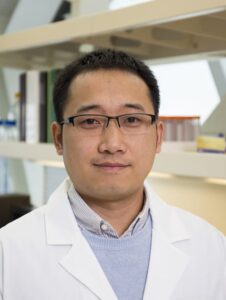DNA ‘organizer’ helps cells store and access genetic information
August 7, 2025

When it comes to organization, our cells give even the most popular tidiness influencers a run for their money.
Nowhere is this more evident than in the nucleus, the operational center of the cell. The nucleus is home to roughly six-and-a-half feet of DNA tightly packed into a space 50 times smaller than a grain of sand.
But DNA isn’t like old clothes or holiday decorations: it can’t simply be squeezed haphazardly into the nucleus.
Instead, it must be carefully spooled into chromatin, a tightly coiled combination of DNA wrapped around wheel-like proteins. In humans, chromatin is then further condensed into a set of 23 chromosomes.
This elegant organizational system is important, says VAI’s , because the way DNA is packaged and stored has profound impacts on health and disease.

Pfeifer is an expert in epigenetics, a field that explores mechanisms that ensure the right genetic instructions are used at the right time. Organizing and packaging DNA are essential features of epigenetics and directly affect how these instructions are accessed.
When cells can’t retrieve the right genetic information, the results can be devastating: cancer cells may continue to grow unchecked, immune cells may lose their ability to fight infections and other important maintenance processes break down.
“Studying DNA organization helps us better understand the basis of disease and find ways to fix problems,” Pfeifer said. “These processes happen out of sight and out of mind, but they are incredibly important parts of sustaining health.”
A compartment for everything

Although there’s still much we don’t know about the intricacies of DNA packaging, new findings from Pfeifer’s lab offer important insights. In a study published in the journal Nature Communications, Pfeifer, Zhijun Huang, Ph.D., and colleagues reveal a never-before-seen look into the fine details of a key DNA organization strategy: “compartments.”
Compartments house DNA regions that comprise millions of bases — the rungs that make up DNA’s ladder-like structure. There are two types of compartments: active compartments, which contain DNA that is actively being used, and inactive compartments, which house DNA not currently in use. Until Pfeifer’s new study, we didn’t know exactly how active and inactive compartments were established or maintained.

His team identified a protein called SMCHD1 as a central player that maintains the separation of DNA into active and inactive compartments in muscle cells. SMCHD1 also is responsible for determining where the compartments are stored in the nucleus. Active compartments are kept closer to the center of the nucleus while inactive compartments are pushed to the outer edge of the nucleus. This system ensures physical distance between active and inactive DNA.
When SMCHD1 is defective, the three-dimensional organization of DNA breaks down, causing many inactive compartments to become active. This allows silenced genes — genes not actively in use — to switch on when they are not needed. Such accidental re-activation can wreak havoc on the normal function of cells and lead to disease.
“SMCHD1 acts like an anchor for keeping compartments in place and, in the case of inactive compartments, blocking access to prevent activation,” Pfeifer said. “We’re excited about this discovery for two reasons: one, we now have a clearer idea of how this fundamental process works and two, we have new opportunities for exploring SMCHD1’s role in disease, including a rare form of muscular dystrophy.”
The next steps
Facioscapulohumeral muscular dystrophy type 2 (FSHD2) is a rare genetic disorder that causes muscles in the face, shoulder blades and upper arms to weaken and atrophy. Symptoms usually appear during adolescence and worsen throughout life. There is no cure for FSHD2, and treatment focuses on symptom management.
FSHD2 is caused by mutations in SMCHD1 that interfere with the protein’s ability to regulate chromatin organization in muscle cells. Using their new discovery as a guidepost, Pfeifer and his team plan to further investigate how SMCHD1 influences this rare form of muscular dystrophy.
The work is in its early days, but the initial findings are promising, Pfeifer says.
“Right now, there aren’t many options for people with FSHD2,” he adds. “Our characterization of SMCHD1’s role in organizing DNA compartments is just the starting point. I’m hopeful that we find new opportunities to translate our understanding of these fundamental processes into ways that meaningfully improve lives.”
Funding Acknowledgement
Research reported in this publication was supported by the National Institute of Arthritis and Musculoskeletal and Skin Diseases of the National Institutes of Health under award no. R01AR079174 (Pfeifer). The content is solely the responsibility of the authors and does not necessarily represent the official views of the National Institutes of Health.

